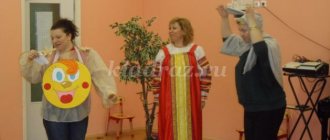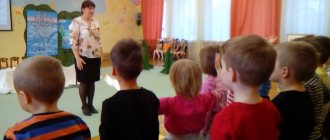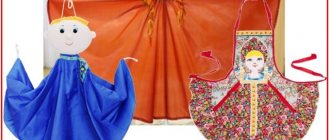Project on theatrical activities in the middle group
Irina Gimaeva
Project on theatrical activities in the middle group
Project type : practice-oriented
Age of children: middle group
Project participants : children, teachers, parents
Relevance: “ The theater is a magical world . He gives lessons in beauty, morality and ethics. And the richer they are, the more successful the development of the spiritual world of children is” (B. M. Teplov)
.
The most popular and exciting area in preschool education is theatrical activities . Creative activity and the development of human creative abilities are the main part of the socio-economic and spiritual directions of the modern and social order. Particular importance in children's educational institutions should be given to theatrical activities , all types of children's theater , because they help to form the correct model of behavior in the modern world, improve the general culture of the child, introduce him to spiritual values, introduce him to children's literature, music, fine arts, and the rules of etiquette , rituals, traditions. Improve the skill of embodying certain experiences in the game, encourage the creation of new images, encourage thinking.
Theatrical activities are the most common type of children's creativity. It is close and understandable to the child. Theater activities help develop the child’s interests and abilities; contribute to general development, the manifestation of curiosity, and the desire to learn new things. In theatrical activities, the child liberates himself, conveys his creative ideas, and receives satisfaction from the activity . Theatrical activities help to reveal the child’s personality, his individuality, and creative potential. The child has the opportunity to express his feelings, experiences, emotions, and resolve his internal conflicts.
The implementation of this project will make the life of children interesting and meaningful, filled with vivid impressions, interesting activities, and the joy of creativity.
Problem: inability to convey the emotional character of the characters. Insufficient vocabulary and related speech.
The goal of the project : to consistently introduce children to various types of theater , develop initiative, independence, connected speech, imagination and fantasy.
Project objectives :
-Develop expressive speech in children;
-Arouse in children an interest in theater , a desire to participate in theatrical activities ;
-Promote the development of children's creative activity;
-Development of fine motor skills of the hands.
-Involve parents in making characters based on fairy tales;
-Exhibition of drawings “We are from a fairy tale”
;
theater and joint theatrical activities among children and parents ;
-Photo vernissage “To the puppet theater with the family ”
-Develop a plan for the year;
-Develop scenarios for open events for the year.
-Through a system of various events, basic concepts about children's theatrical activities ;
-Acquisition by children of primary skills in the field of theatrical art ;
-Development of the emotional background and speech of preschoolers, replenishment of the theater corner ;
-Enthusiastic use of the theater center by children in the group in independent activities and good performance in acting for children 4-5 years old.
Stage 1 - preparatory, information and research:
of theater together by the teacher with parents and children ;
-Reading works of fiction (fairy tales, stories)
;
-Development of an entertainment scenario for children.
The second stage is the main one:
Preliminary work: parents and children made puppet theater characters for the fairy tale “Puff”
processing N. Myalika.
-Introducing children to the Belarusian fairy tale “Pykh”
processing N. Myalika.
Consideration of the heroes of the puppet theater .
-Individual work with fairy tale characters.
-Individual work with characters on onomatopoeia of fairy tale heroes.
-Demonstration of the fairy tale “Pykh”
.
Preliminary work: parents and children made carton theater characters for the fairy tale “Turnip”
.
-Reading the Russian folk tale “Turnip”
.
-Examination of the heroes of the carton theater .
-Re-reading the fairy tale.
-Individual work with fairy tale characters.
-Individual work with characters on onomatopoeia of fairy tale heroes.
-Demonstration of the fairy tale “Turnip”
.
Preliminary work: parents and children made puppet theater characters for the fairy tale “Teremok”
.
-Reading the Russian folk tale “Teremok”
.
-Examination of the heroes of the puppet theater .
-Re-reading the fairy tale.
-Individual work with fairy tale characters.
-Individual work with characters on onomatopoeia of fairy tale heroes.
-Demonstration of the fairy tale “Teremok”
.
Preliminary work: parents, together with their children, made characters from the Finger Theater for the fairy tale “Zayushkina’s Hut”
.
-Reading the fairy tale “Zayushkina’s hut”
.
-Examination of the heroes of the Finger Theater .
-Individual work with the characters of the story.
-Individual work with characters on onomatopoeia of the heroes of the story.
-Demonstration of the fairy tale “Zayushkina’s hut”
.
Preliminary work: parents and children created Finger Theater characters for the fairy tale “Wintermovie”
processing I. Sokolova-Mikitova.
-Introducing children to the Russian folk tale “Wintermovie”
processing I. Sokolova-Mikitova.
-Individual work with fairy tale characters.
-Individual work with characters on onomatopoeia of fairy tale heroes.
-Demonstration of the fairy tale “Wintermovie”
.
Preliminary work: parents and children made finger theater characters for the fairy tale “Kolobok”
.
-Reading the Russian folk tale “Kolobok”
.
-Examination of the heroes of the Finger Theater .
-Re-reading the fairy tale.
-Individual work with characters to convey the character’s character.
-Individual work with characters.
-Demonstration of the fairy tale “Kolobok”
.
Preliminary work: parents and children made cardboard theater characters for the fairy tale “The Three Bears”
.
-Reading the fairy tale by L. N. Tolstoy “The Three Bears”
.
Project “Project of musical and theatrical activities “The Magic World of Theater” in senior group No. 2”
LIST OF DIDACTIC MATERIALS (LITERATURE) FOR SOLVING THE TASKS AND GOALS OF THE PROJECT
1. “Musical palette” No. 6 2005
2. “Musical Director” No. 6, 7, 8 2008; No. 1 2009
3. S. I. Merzlyakova “The Magic World of Theater” (for children 5-7 years old).
4. A. I. Burenina “Rhythmic mosaic”.
5. N. A. Sorokina “Theatre, creativity, children”
6. “Puppet theater for preschoolers” T. N. Karamanenko, Yu. G. Karamanenko
CONSULTATION FOR TEACHERS
THEATER GAMES
THE PATH TO CHILDREN'S CREATIVITY.
A developing environment that promotes self-expression in the process of artistic activity is of great importance for the development of a child’s personality.
A person who is equally developed both emotionally and intellectually can be called truly integral. We must strive to develop both in a child. Unfortunately, most often, emotional education is neglected, giving preference to the development of intellectual capabilities.
“The danger is not that machines will start thinking. Like a person, but the fact is that a person will begin to think like a machine!” – Professor G. Suvorov.
“Harmony of mind and heart is the ultimate goal of educating a modern person” - D. B. Kabalevsky.
A child who gets used to expressing his emotions through various types of artistic activities begins to view his “I” in a new way, his own behavior and the behavior of others, his relationships with people, as well as nature and the world around him. Raising a whole personality is not an easy task. This requires conditions: the presence of a teacher and the presence of an environment that evokes a positive emotional response from the child. Hence the need arises for forms of classes in which each child will actively experience the content of the lesson and actively participate in artistic self-expression. A preschooler should not just sit in class and obediently complete tasks. The joy of creativity, an active relationship with an adult, takes the child from a position of passive acquisition of knowledge, skills and abilities to a position of creative activity, initiative, and independence. Only this can develop creativity in every child.
With all the variety of types of artistic activity, theatrical games occupy a special place in the educational process. They are designed for children's activity, for their creative interaction with each other, for artistic and active communication with adults. Through theatrical play, the child receives information about the world around him, and his creative abilities are formed. With the help of such expressive means as intonation, facial expressions, gestures, gait, literary works, fairy-tale plots, and comic dialogues are acted out.




